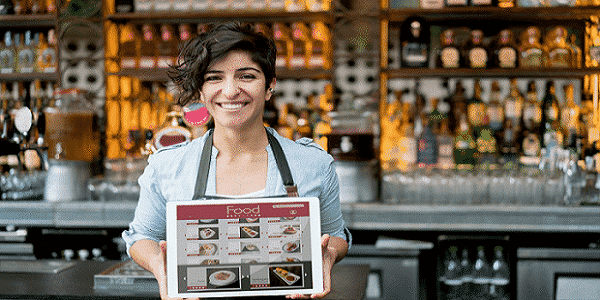You’ve finally done it: the restaurant you’ve been dreaming of for years is ready to open. Soon, customers will be sitting down and ordering your food. Drinks poured, laughter filling the dining room. Families enjoying a night out, friends catching up over happy hour drinks.
You and your hardworking staff running around and making it all happen—the sounds of the kitchen, the clinking of plates, forks, and knives. Of course, there’s more to running a restaurant in the 21st century than just cooking and serving food.
To operate a restaurant successfully, you need a restaurant marketing plan. This could include billboard advertising, it could include taking out advertisement space in a local newspaper, it could mean paying to promote your eatery on Yelp. One thing that is crucial for every modern restaurateur to do is to create a restaurant website.
Why You Need a Restaurant Website
While restaurants still attract customers through traditional means such as word of mouth, foot traffic, and roadside advertising, today’s customers frequently find places to eat online.
User-generated content (UGC) is a big part of this. New customers rely on previous customers’ reviews on websites like Yelp or Google reviews. They search “restaurants near me” in their map apps on their phones, and they’re shown exactly that, with better-reviewed restaurants shown with higher priority.
No matter how a customer learns of your restaurant, if it’s close to them or online reviews give them a positive impression, they’re probably going to want to know more.
What’s on the menu? What does the dining room look like? Is there outdoor seating? What are the hours? These are all important questions, and the answers (or lack thereof) to each question could make your customers decide whether or not they want to come to your business and spend their hard-earned money — ultimately making or breaking your business.
There are two main reasons to create a website for your restaurant. The first is so that when people use a search engine to find information on your business, your website appears in the results, ideally at the very top.
The second is so your website can serve as the primary source for information on your restaurant. Review sites might feature dated menu items or incorrect hours. If you keep a website and update it every time some aspect of your business changes that customers need to know about, you can rest assured that your customers will stay adequately informed.
What Information Do You Need on Your Website?
You don’t need to have a huge, complex restaurant website. The purpose should be to clearly and efficiently inform both new and regular customers about what they can expect from your business.
Every restaurant website should have this information, either all on separate pages or combined into a few different pages:
- Location and hours
- Menu
- Photo gallery
- Contact information
- Reservation information
- About
- Reviews
- Delivery information
Before you begin creating your website or hire someone else to do it for you, make sure you’ve gathered all of the above information. Let’s walk through what you’ll need.
Location and Hours
This is self-explanatory. You’ll want to display this prominently on your homepage or a page of its own linked from the homepage. If your website has a footer, this should be in it on every page.
Menu
Extremely important! Today’s customer needs to know what the options are. If they have dietary restrictions, they’ll want to know if your restaurant even has food they can eat.
Give your menu its own page on your website, including information on vegetarian, vegan, and gluten-free options. Also include information about spice levels if applicable.
Include prices, unless your business model would benefit from excluding that information, like if you operate a fine-dining establishment with high prices.
Photo Gallery
In today’s world, where people love taking photos of their food and sharing them on social media, it’s essential to have appetizing images of your food on your restaurant website.
Newer smartphones tend to have excellent cameras, so if you’re confident in your photography skills, you might be able to take your own photos. If you’re not, maybe you know someone who could do this for you.
If necessary, find a local photographer whose work you like, and hire them to take them. You don’t need to include a photograph of every single dish — pick only the most photogenic ones.
It’s also good to have pictures of your space so that potential customers can get a read on the ambiance.
Contact Information
Always include a phone number as well as an email address, if applicable. Customers need this to ask questions about hours, especially on holidays when some businesses might be closed.
They also might want to make a reservation or inquire about delivery. This should be placed near your location and hours and in the footer of your website on every page if you choose to use one.
Reservation Information
If your restaurant takes reservations, make sure customers can do so through a link on your website. These days, there are third-party reservation software providers such as Resy and OpenTable.
If you’d prefer customers call to reserve a table, make that clear on your website.
About
It’s good to have one or two paragraphs simply telling your story. Your restaurant’s biography should speak to your individual story; every business will do this a little bit differently.
You might include information on you and your background if that’s important to the restaurant concept. Talk about what the restaurant is intended for — celebration dinners, casual drinks, a quick lunch, whatever it is that will tell customers what they should expect.
You can write this yourself or find a freelance writer to work with you to make it perfect.
Reviews
If your restaurant has been written up in a local publication or food blog, and the writer had great things to say, include some quotes and links to those reviews.
You can also source this information from user reviews. The point is to show potential customers that other people loved your business, and they will too.
Delivery Information
Not every restaurant does delivery. If you do, make sure your website tells customers what they need to do to make it happen.
If your restaurant has in-house delivery, make that clear and provide a number to call and delivery range and hours. If you use a third-party delivery partner, make that clear too.
How to Build Your Restaurant Website
Once you’ve gathered all the information you need, it’s time to actually build your site. There are multiple ways to do this.
If you’re tech-savvy, you can use software like Wix, Squarespace, or Bentobox. These platforms make it simple to create a website that both works well and looks great. Bentobox is actually designed specifically for restaurateurs like you.
If you don’t want to build the website yourself, find a freelancer. You might ask other restaurant owners whose websites you admire, what they did or who they hired. Otherwise, search the web for website developers. Freelance marketplaces like Upwork are a great place to start; you can set a specific budget and let people bid for the opportunity to work with you.
Whatever route you choose, whether you build the site yourself or work with a professional to get it done, you’ll soon have the website you need. Once it’s built, you can improve the SEO if web searches for your business aren’t leading people to your website. Again, this can be solved by working with freelancers or doing further research of your own.
By now, you should have a solid framework of why you need a restaurant website and what it takes to create one. Remember: if you build it, new customers will come!


 By Talitha Turkin
By Talitha Turkin By IndoorMedia Marketing
By IndoorMedia Marketing